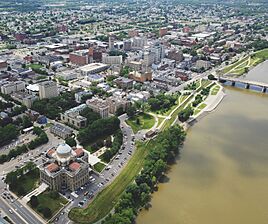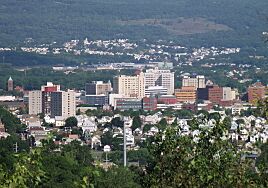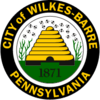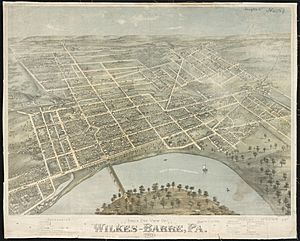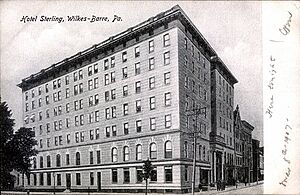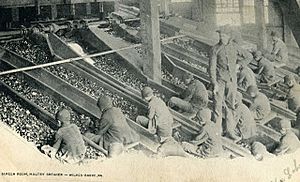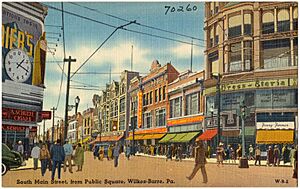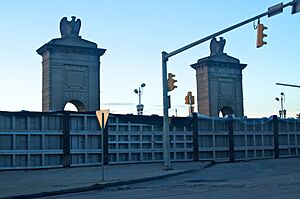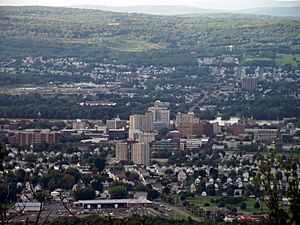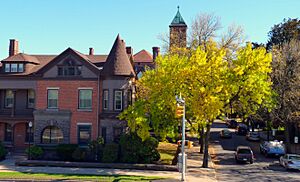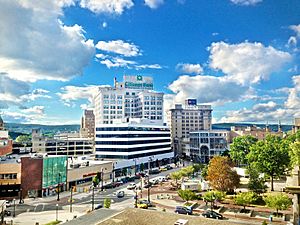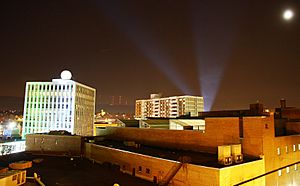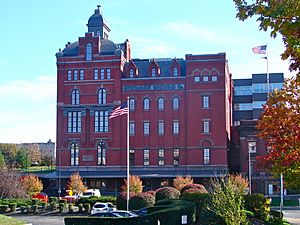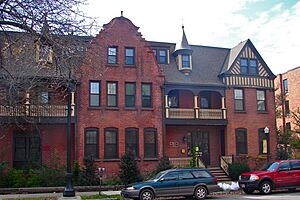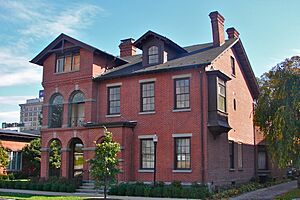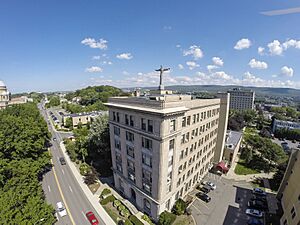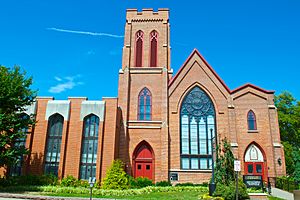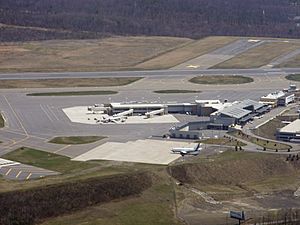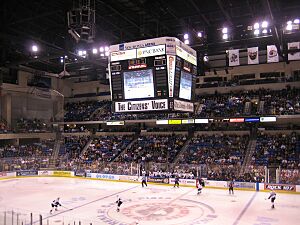Wilkes-Barre, Pennsylvania facts for kids
Quick facts for kids
Wilkes-Barre
|
|||
|---|---|---|---|
|
Downtown Wilkes-Barre along the Susquehanna River
Wilkes-Barre Public Square
Luzerne County Courthouse
Panorama of Wilkes-Barre
|
|||
|
|||
| Nickname(s):
The Diamond City, W-B, Coal City
|
|||
| Motto(s):
Pattern After Us
|
|||
| Country | United States | ||
| State | Pennsylvania | ||
| County | Luzerne | ||
| Founded | 1769 | ||
| Incorporated | 1806: Borough | ||
| 1871: City | |||
| Named for | John Wilkes, Isaac Barré | ||
| Government | |||
| • Type | Mayor–council | ||
| • Body | Wilkes-Barre City Council | ||
| Area | |||
| • City | 7.19 sq mi (18.63 km2) | ||
| • Land | 6.85 sq mi (17.74 km2) | ||
| • Water | 0.35 sq mi (0.90 km2) | ||
| Elevation | 525 ft (160 m) | ||
| Population
(2020)
|
|||
| • City | 44,328 | ||
| • Density | 6,473.13/sq mi (2,499.19/km2) | ||
| • Urban | 401,884 (US: 100th) | ||
| • Metro | 562,037 | ||
| Time zone | UTC−5 (EST) | ||
| • Summer (DST) | UTC−4 (EDT) | ||
| ZIP Codes |
18701–18703, 18705, 18706, 18710, 18711, 18762, 18764–18767, 18769, 18773
|
||
| Area code | 570 and 272 | ||
| FIPS code | 42-85152 | ||
Wilkes-Barre is a city in Luzerne County, Pennsylvania, United States. It's the main city of the county. The city is in the middle of the Wyoming Valley in Northeastern Pennsylvania. In 2020, about 44,328 people lived there.
Wilkes-Barre is the second-largest city in the Scranton–Wilkes-Barre–Hazleton area. This larger area has about 567,559 people. It is the fifth-largest metropolitan area in Pennsylvania.
Many cities and towns in Northeastern Pennsylvania are built close together. This makes them feel like one big city. Wilkes-Barre and the surrounding area are surrounded by mountains. The Susquehanna River flows through the valley and forms the city's western edge.
Wilkes-Barre was started in 1769. It became a borough in 1806 and a city in 1869. The city grew very fast in the 1800s. This was because a lot of coal was found nearby. Many immigrants came to work in the coal mines. Mining anthracite coal helped the city's industries grow. Wilkes-Barre was very successful in the early 1900s. Its population reached over 86,000 people in 1930.
After World War II, the city's economy slowed down. The coal industry declined. The Knox Mine disaster in 1959 caused many mines to flood and close. Today, Wilkes-Barre's population is about half of what it was in the 1930s. But it is still the biggest city in Luzerne County.
Wilkes-Barre is about 49 miles (79 km) northwest of Allentown. It is also about 97 miles (156 km) northwest of Philadelphia. And it is 106 miles (171 km) west-northwest of New York City.
Contents
History of Wilkes-Barre
Early Days and Conflicts

In the 1700s, the Wyoming Valley was home to the Shawnee and Lenape Native American tribes. In 1753, a group from Connecticut wanted to settle this valley. Connecticut bought the land from Native Americans. But Pennsylvania also said the land was theirs from a purchase in 1736.
In 1762, about 200 settlers from Connecticut built homes near Mill Creek. They planted crops and then went back to New England for the winter.
The Connecticut settlers returned in 1763 with their families. Some Iroquois also visited the area. They wanted to turn the Lenape tribe against the colonists. On April 19, 1763, the home of the Lenape chief, Teedyuscung, was burned. He died in the fire. The Iroquois made the Lenape believe the settlers did this. So, on October 15, 1763, the Lenape attacked the colonists. Thirty settlers were killed, and some were taken prisoner. Those who escaped went back to New England. The Lenape then burned what was left of the settlement.
In 1769, the Connecticut settlers came back to the Wyoming Valley. They created five townships. Each was five square miles and given to 40 settlers. Wilkes-Barre Township was one of these. It was named after John Wilkes and Isaac Barré. They were British politicians who supported the American colonies. People from Pennsylvania also arrived in the valley that year.
The Connecticut settlers built Fort Durkee. This led to the Pennamite-Yankee War. This was a series of small fights between settlers from Pennsylvania and Connecticut. The land changed hands many times. The Congress of the Confederation was asked to help. On December 30, 1782, they decided the land belonged to Pennsylvania. The Wyoming Valley became part of Northumberland County.
During the American Revolutionary War, two forts were built in Wilkes-Barre. Fort Wilkes-Barre was finished in 1778. But it was left and burned after the Battle of Wyoming that year. Fort Wyoming was built when the Continental Army came back to the valley. It was used as a base for the Sullivan Expedition in 1779.
After the Revolutionary War, Pennsylvania said the Connecticut settlers were not citizens. They could not vote and had to give up their land claims. In May 1784, armed men from Pennsylvania forced the Connecticut settlers out of the valley. By November, the settlers came back with more people. They captured and destroyed Fort Dickinson in Wilkes-Barre. After this win, they suggested creating a new state called Westmoreland.
To keep the land, Pennsylvania's government made a deal with the Connecticut settlers. The settlers would become citizens of Pennsylvania. They would also get their land claims back from before the Decree of Trenton. As part of the deal, Pennsylvania would create a new county in Northeastern Pennsylvania. The settlers agreed.
On September 25, 1786, Pennsylvania created Luzerne County. It was made from part of Northumberland County. It was named after Chevalier de la Luzerne, a French soldier and diplomat. Wilkes-Barre became the main government center for the new county. This stopped the idea of a new state.
In 1797, Louis Philippe I, who later became King of France, stayed in Wilkes-Barre. He was traveling to the French Azilum settlement.
Growth in the 1800s
Wilkes-Barre's population grew very fast in the 1800s. This was because anthracite coal was found nearby. In 1808, Judge Jesse Fell of Wilkes-Barre found a way to burn anthracite coal easily. He used an iron grate. This made coal a very popular fuel.
This led to the coal industry growing in Northeastern Pennsylvania. Wilkes-Barre was called "The Diamond City." This was because it produced so much coal. Many immigrants came to Wilkes-Barre in the 1800s. They wanted jobs in the coal mines.
Throughout the 1800s, canals and railroads were built. They helped mine and transport coal. Hundreds of thousands of immigrants came to the city. They looked for jobs in the many mines and coal plants. In 1806, Wilkes-Barre Borough was created. It became a city in 1871. This was because the population grew so much. At its peak, Wilkes-Barre had over 86,000 people in the 1930s and 40s.
New industries started in the city. The Vulcan Iron Works made railway engines from 1849 to 1954. Many big companies started in Wilkes-Barre. These included Woolworth's, Sterling Hotels, and Stegmaier.
Even with a strong economy, the city faced natural disasters. There were often floods from the Susquehanna River. On August 19, 1890, a strong tornado hit the city. It killed 16 people and hurt 50. It damaged or destroyed 260 buildings.
The 1900s and Beyond
Wilkes-Barre is in Pennsylvania's Coal Region. The coal mining industry used many child workers in the early 1900s. The National Child Labor Committee worked to stop this. Their photographer, Lewis Hine, took many pictures in the mines near Wilkes-Barre. These photos helped lead to new laws against child labor across the country.
The coal industry continued even with disasters. In 1919, an explosion at Wilkes-Barre's Baltimore Colliery killed 92 miners. The industry declined as the United States started using other energy sources. Most coal mining stopped in Wilkes-Barre after World War II. The 1959 Knox Mine Disaster flooded many mines. This ended large-scale coal mining in the area. The city lost many jobs as industries changed.
In 1926, Planters Peanuts Company was started in Wilkes-Barre. It kept its main office there until 1961. In 1929, baseball player Babe Ruth hit a very long home run at Artillery Park in Wilkes-Barre.
On November 8, 1972, Wilkes-Barre became important for modern cable television. Home Box Office (HBO) first launched in the city. About 365 cable TV users were the first to get this new service.
Flooding Challenges
Manufacturing and retail were strong industries in Wilkes-Barre. But the city's economy was badly hit by Tropical Storm Agnes in 1972. The storm caused the Susquehanna River to rise very high. It went four feet above the city's levees. Downtown Wilkes-Barre was flooded with nine feet of water.
The storm caused 128 deaths. Most people drowned because they were stuck in their cars. Almost 400,000 homes and businesses were destroyed. About 220,000 people in Pennsylvania lost their homes. The damage in Pennsylvania was about $2.1 billion. President Richard Nixon sent help to the area.
Through the 1970s and 1980s, Wilkes-Barre built a strong levee system. It was designed to protect against floods as bad as Agnes. The levees are 41 feet (12 m) high. They were finished in 2003 and cost about $250 million. The levees have protected the city from floods in 1996, 2004, and 2006. The United States Army Corps of Engineers has praised the levees. In 2006, 200,000 residents were told to leave their homes because of a flood warning. But the flood was not as bad as predicted.
In August 2011, Hurricane Irene caused the Susquehanna River to rise. Then, from September 6 to 8, heavy rains from Tropical Storm Lee and Hurricane Katia caused more flooding. The Susquehanna River reached a record high of 42.66 feet (13.00 m) in Wilkes-Barre. This was almost 2 feet (0.61 m) higher than during Hurricane Agnes in 1972. The levees protected Wilkes-Barre. But nearby towns like West Pittston and Plymouth were badly flooded.
Wilkes-Barre in the 21st Century
City Improvements
In 2005, Mayor Thomas M. Leighton started a campaign to improve the city's spirit. A new downtown theater complex opened in 2006. Wilkes University and King's College also expanded. Old street lights in Public Square were replaced with new green ones.
Wilkes-Barre celebrated its 200th anniversary in 2006. Many events were planned, but heavy rains caused them to be canceled. Most people in the city had to leave their homes on June 28, 2006. The celebration was moved to Labor Day weekend.
The Riverfront revitalization project, called River Common, started in 2007 and finished in 2010. It made the riverfront open to the public. The area now has an amphitheater for shows. It also has ramps and sidewalks for easier access. Fountains and colorful lights were added under two bridges. The project goes from the Luzerne County Courthouse for about four blocks. The River Common has hosted concerts and charity events.
Since the River Common was finished, other city improvements have happened. New crosswalks were put in downtown. Signs remind drivers that pedestrians have the right-of-way. The James F. Conahan Intermodal Transportation Facility was completed. It provides parking and moved county buses from Public Square. This has helped reduce traffic.
The widening of Coal Street was finished in 2012. This major road connects Wilkes-Barre City with Wilkes-Barre Township. The new Coal Street has four lanes instead of two. This makes travel between the city and the commercial township much easier. In 2013, Hotel Sterling was torn down. Its basement was damaged by floods, which made the building unsafe. New buildings are now being built where the hotel once stood.
Geography of Wilkes-Barre
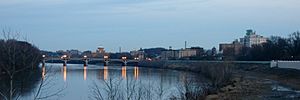
Wilkes-Barre covers about 7.2 square miles (18.6 km2). Most of this is land, and a small part is water. The Susquehanna River borders the city to the west. Much of Downtown Wilkes-Barre is on a wide flat area near the river. Large floodwalls protect most of the city from floods. The downtown area is about 550 feet (168 m) above sea level. As you go away from the river, the land gets higher. Wilkes-Barre Mountain is a natural barrier southeast of the city.
Wilkes-Barre is about 63 miles (101 km) northwest of Allentown. It is also about 113 miles (182 km) northwest of Philadelphia. The city and the Wyoming Valley are surrounded by mountains. The Pocono Mountains are to the east. The Endless Mountains are to the north and west. The Lehigh Valley is to the south. The Susquehanna River flows through the valley and forms the city's northwestern border.
City Neighborhoods
Wilkes-Barre has more than a dozen neighborhoods:
- Central City: Also called "Downtown." This area is between the Susquehanna River and Wilkes-Barre Boulevard. It was the original part of Wilkes-Barre. It has most of the city's tall buildings and its main public square. Many companies have their offices here. Thousands of people live or work downtown every day.
- North End: This area is northeast of Downtown. It has both city and suburban parts. North End is known for its interesting buildings.
- Parsons: This neighborhood is also northeast of Downtown. It is a quiet, suburban area. It has two city parks, a golf course, and some factories.
- Miners' Mills: This community is named after a local family. It is the last neighborhood on the northeastern edge of the city.
- East End: This neighborhood is directly east of Downtown. East End, Heights, and Mayflower are newer areas. They were mostly built in the 1900s.
- Heights: This area is southeast of Downtown. It is between East End and Mayflower.
- Mayflower: This area is south of Downtown. It used to have many large mansions. Today, it has several housing communities. You can get a great view of Downtown from the higher parts of Mayflower.
- South Wilkes-Barre: This neighborhood is southwest of Downtown. In the 1900s, it was home to the main offices of Planter's Peanuts and Bell Telephone. St. Nicholas Roman Catholic Church, one of the tallest churches in the county, is here.
- Goose Island: This area is in the southwestern part of the city. It is between South Wilkes-Barre and Rolling Mill Hill.
- Rolling Mill Hill: This neighborhood is also in the southwestern part of the city.
- Iron Triangle: This is another community southwest of Downtown.
- Other neighborhoods: There are also smaller neighborhoods like Brookside and Barney Farms.
Nearby Towns
Wilkes-Barre is next to these towns:
- Wilkes-Barre Township (southeast)
- Plains Township (east and northeast)
- Kingston (north)
- Edwardsville (northwest)
- Larksville (west)
- Hanover Township (southwest)
- Bear Creek Township (southwest)
Climate and Weather
Wilkes-Barre has a humid continental climate. Summers are hot, and winters are cold. Temperatures can change a lot. The mountains around the city affect the weather. This causes different temperatures and rainfall nearby.
Winters are cold, with an average January temperature of 28.0°F (-2.2°C). Temperatures below 0°F (-18°C) happen about 2.5 days a year. There are about 35 days where the temperature stays below freezing. The city gets about 45.1 inches (115 cm) of snow each winter. Big snowstorms are rare, but they can sometimes disrupt daily life.
Summers are warm, with an average July temperature of 73.7°F (23.2°C). Temperatures above 90°F (32°C) happen about 11.7 days a year. It rarely gets above 100°F (38°C). Spring and fall weather can be unpredictable, but it is usually mild.
Wilkes-Barre gets about 38.7 inches (98.3 cm) of rain each year. The rain is spread out, but summer months get more. Extreme temperatures have ranged from -21°F (-29°C) to 103°F (39°C). The city gets about 2,303 hours of sunshine each year.
| Climate data for Wilkes-Barre/Scranton Int'l Airport, Pennsylvania (1981–2010 normals, extremes 1901–present ) | |||||||||||||
|---|---|---|---|---|---|---|---|---|---|---|---|---|---|
| Month | Jan | Feb | Mar | Apr | May | Jun | Jul | Aug | Sep | Oct | Nov | Dec | Year |
| Record high °F (°C) | 69 (21) |
76 (24) |
85 (29) |
93 (34) |
93 (34) |
99 (37) |
103 (39) |
102 (39) |
100 (38) |
91 (33) |
81 (27) |
71 (22) |
103 (39) |
| Mean maximum °F (°C) | 55.4 (13.0) |
56.4 (13.6) |
69.6 (20.9) |
81.3 (27.4) |
86.6 (30.3) |
89.8 (32.1) |
91.8 (33.2) |
90.0 (32.2) |
85.7 (29.8) |
77.3 (25.2) |
68.7 (20.4) |
57.5 (14.2) |
93.4 (34.1) |
| Mean daily maximum °F (°C) | 33.2 (0.7) |
36.8 (2.7) |
46.2 (7.9) |
59.1 (15.1) |
69.7 (20.9) |
77.7 (25.4) |
81.9 (27.7) |
79.9 (26.6) |
72.3 (22.4) |
60.7 (15.9) |
49.4 (9.7) |
37.5 (3.1) |
58.8 (14.9) |
| Mean daily minimum °F (°C) | 18.5 (−7.5) |
20.7 (−6.3) |
27.6 (−2.4) |
38.2 (3.4) |
47.6 (8.7) |
56.5 (13.6) |
60.9 (16.1) |
59.5 (15.3) |
52.1 (11.2) |
41.1 (5.1) |
33.3 (0.7) |
23.8 (−4.6) |
40.1 (4.5) |
| Mean minimum °F (°C) | −0.8 (−18.2) |
3.2 (−16.0) |
9.1 (−12.7) |
24.0 (−4.4) |
34.4 (1.3) |
43.1 (6.2) |
49.4 (9.7) |
47.1 (8.4) |
37.5 (3.1) |
28.3 (−2.1) |
18.9 (−7.3) |
5.9 (−14.5) |
−3.1 (−19.5) |
| Record low °F (°C) | −21 (−29) |
−19 (−28) |
−4 (−20) |
8 (−13) |
27 (−3) |
34 (1) |
43 (6) |
38 (3) |
29 (−2) |
19 (−7) |
6 (−14) |
−13 (−25) |
−21 (−29) |
| Average precipitation inches (mm) | 2.37 (60) |
2.03 (52) |
2.55 (65) |
3.33 (85) |
3.52 (89) |
4.03 (102) |
3.79 (96) |
3.41 (87) |
4.07 (103) |
3.34 (85) |
3.14 (80) |
2.68 (68) |
38.26 (972) |
| Average snowfall inches (cm) | 14.2 (36) |
9.3 (24) |
9.0 (23) |
3.3 (8.4) |
0 (0) |
0 (0) |
0 (0) |
0 (0) |
0 (0) |
0.1 (0.25) |
2.9 (7.4) |
7.4 (19) |
46.2 (117) |
| Average precipitation days (≥ 0.01 in) | 12.0 | 11.0 | 11.8 | 12.3 | 13.2 | 12.8 | 11.2 | 11.3 | 10.2 | 10.7 | 11.2 | 11.5 | 139.2 |
| Average snowy days (≥ 0.1 in) | 9.3 | 7.7 | 5.0 | 1.7 | 0 | 0 | 0 | 0 | 0 | 0.1 | 2.1 | 7.1 | 33.0 |
| Average relative humidity (%) | 70.1 | 67.5 | 63.3 | 60.4 | 64.6 | 70.5 | 71.1 | 73.8 | 75.2 | 71.6 | 71.8 | 72.5 | 69.4 |
| Mean monthly sunshine hours | 130.3 | 143.7 | 185.7 | 210.5 | 246.9 | 269.7 | 285.7 | 257.2 | 200.2 | 173.3 | 104.3 | 95.9 | 2,303.4 |
| Percent possible sunshine | 44 | 48 | 50 | 53 | 55 | 60 | 62 | 60 | 54 | 50 | 35 | 33 | 52 |
| Source: NOAA (relative humidity 1964–1990, sun 1961–1990) | |||||||||||||
Parks and Fun Activities
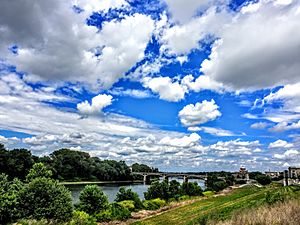
Wilkes-Barre has a Downtown Riverfront Park system with 91 acres of open space.
Kirby Park is a public park along the western bank of the Susquehanna River. Many people use Kirby Park for fun. The Kirby Family gave the park to the city. Hundreds of thousands of people visit it every year. The park hosts the city's annual Cherry Blossom Festival in April. It also hosts the July 4th Celebration. It has tennis courts, a fitness trail, a pond, walking paths, and softball fields.
Nesbitt Park is also on the west side of the Susquehanna River, across from Kirby Park. It is open to everyone. It has walking paths and places for picnics.
The River Common is on the eastern bank of the Susquehanna River. The Market Street Bridge goes through the park. The River Common connects to the Luzerne County Courthouse grounds. It has a large amphitheater that can hold 750 people. There are also paved walkways, gardens, trees, and seating areas. A fishing pier and two grand entrances connect the city to the river.
People of Wilkes-Barre
| Historical population | |||
|---|---|---|---|
| Census | Pop. | %± | |
| 1800 | 835 | — | |
| 1810 | 1,225 | 46.7% | |
| 1820 | 755 | −38.4% | |
| 1840 | 1,718 | — | |
| 1850 | 2,723 | 58.5% | |
| 1860 | 4,253 | 56.2% | |
| 1870 | 10,174 | 139.2% | |
| 1880 | 23,339 | 129.4% | |
| 1890 | 37,718 | 61.6% | |
| 1900 | 51,721 | 37.1% | |
| 1910 | 67,105 | 29.7% | |
| 1920 | 73,833 | 10.0% | |
| 1930 | 86,626 | 17.3% | |
| 1940 | 86,236 | −0.5% | |
| 1950 | 76,826 | −10.9% | |
| 1960 | 63,068 | −17.9% | |
| 1970 | 58,856 | −6.7% | |
| 1980 | 51,551 | −12.4% | |
| 1990 | 47,523 | −7.8% | |
| 2000 | 43,123 | −9.3% | |
| 2010 | 41,498 | −3.8% | |
| 2020 | 44,328 | 6.8% | |
| U.S. Decennial Census | |||

The city's population went down from the 1930s to 2010. But it started to grow again by 2020. In 2020, there were 44,328 people living in the city. The population density was about 5,945 people per square mile.
The people living in Wilkes-Barre are from many different backgrounds. In 2020, about 69.8% of the people were White. About 14.9% were African American. About 2.4% were Asian. And about 21.0% were Hispanic or Latino.
In 2000, the average household had 2.42 people. About 22.9% of the population was under 18 years old. About 61.3% were between 19 and 64 years old. And 15.8% were over 65 years old. Females made up 50.6% of the population.
The average income for a household was $37,902. About 26.6% of the city's residents lived below the poverty line.
Local Dialect
The way people speak English in Wilkes-Barre is called Northeast Pennsylvania English.
Religions in Wilkes-Barre
More than half (59.3%) of the city's people are religious.
- 43.8% are Catholic.
- 4.4% are Methodist.
- 3.1% are Lutheran.
- 2.0% are Presbyterian.
- 1.1% are Pentecostal.
- 0.8% practice Judaism.
- 0.6% are Episcopalian.
- 0.5% are Baptist.
- 0.5% practice Islam.
- 0.3% are members of The Church of Jesus Christ of Latter-day Saints.
Economy of Wilkes-Barre
In March 2019, the average income per person in Wilkes-Barre was $18,375. This was lower than the national average. The average household income was $32,484. The unemployment rate in March 2019 was 6.4%. Recent job growth was 0.8%.
Many jobs in the city are in sales, office work, and transportation. In 2016, 30.1% of residents lived below the poverty line. This was more than double the average for Pennsylvania. Big employers in the city include GUARD Insurance Group and Lord & Taylor.
Education in Wilkes-Barre
High Schools
Wilkes-Barre City is part of the Wilkes-Barre Area School District. The district has one high school, Wilkes-Barre Area High School. It opened in 2020. It replaced three older high schools.
Holy Redeemer High School is a Catholic school in Wilkes-Barre. It is managed by the Diocese of Scranton.
Colleges and Universities
There are several colleges and universities in and around Wilkes-Barre:
- Geisinger Commonwealth School of Medicine, Wilkes Barre Campus
- King's College
- Luzerne County Community College
- Misericordia University
- Penn State Wilkes-Barre
- Wilkes University
Libraries
Besides college libraries, Wilkes-Barre has several public libraries. These include three branches of the Osterhout Free Library. The main branch is the headquarters for the Luzerne County Library System.
Transportation in Wilkes-Barre
Airports
Two international airlines fly from the Wilkes-Barre/Scranton International Airport. This airport is in nearby Pittston Township. Smaller, private planes can use the Wilkes-Barre Wyoming Valley Airport in Forty Fort.
Highways
Interstate 81 runs north–south near Wilkes-Barre. The city is also close to the Northeast Extension of the Pennsylvania Turnpike. It is about 10 miles (16 km) north of Interstate 80. The North Cross Valley Expressway connects the city to Dallas in the north.
Buses
The Luzerne County Transportation Authority provides public transportation. It serves the city and the northern part of the county. You can also take a bus to Scranton.
Martz Trailways offers bus service from downtown Wilkes-Barre to other cities. These include Scranton, New York City, Philadelphia, and Atlantic City.
Arts and Culture in Wilkes-Barre
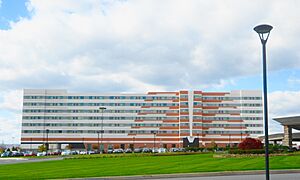
Local Attractions
- Dorothy Dickson Darte Center for the Performing Arts (at Wilkes University)
- F. M. Kirby Center for the Performing Arts
- Frederick Stegmaier Mansion
- Little Theatre of Wilkes-Barre
- Luzerne County Museum
- Mohegan Sun Arena at Casey Plaza
- Mohegan Pennsylvania (Pennsylvania's first casino)
- River Street Historic District
- Stegmaier Brewery
- Wilkes-Barre station
- Wyoming Monument
Media
Times Leader and The Citizens' Voice are the two biggest daily newspapers in Wilkes-Barre. WBRE-TV 28 is the only TV station licensed to Wilkes-Barre. Other TV stations from Scranton and Hazleton also serve the city. Wilkes-Barre has many radio stations for news and music.
Sports Teams
| Club | League | Home Venue | Started | Parent Team | League Championships |
|---|---|---|---|---|---|
| Scranton/Wilkes-Barre RailRiders | IL, Baseball | PNC Field | 1989 | New York Yankees | 2 |
| Wilkes-Barre/Scranton Penguins | AHL, Ice hockey | Mohegan Sun Arena at Casey Plaza | 1999 | Pittsburgh Penguins | 0 |
| Wilkes-Barre/Scranton Mavericks | AF1, Arena football | Mohegan Sun Arena at Casey Plaza | 2024 | N/A | 0 |
Notable People from Wilkes-Barre
- Jane Alexander, lawyer and politician
- Hazel Barnes, philosopher
- Douglas Carter Beane, playwright
- Al Bedner, NFL player
- Ray Black, baseball pitcher
- David Bohm, quantum physicist
- Benjamin Burnley, lead singer of Breaking Benjamin
- Lillian Cahn, co-founder of Coach, Inc.
- George Catlin, artist
- Britton Chance, bio-physicist and Olympic sailor
- Catherine Chandler, poet
- Mark Cohen, street photographer
- Ed Cole, Major League Baseball pitcher
- Colleen Corby, 1960s fashion model
- Michael Costello, racing driver
- Mary Helen Peck Crane, activist and writer
- Amasa Dana, former U.S. Congressman
- Charles B. Dougherty, Army National Guard major general
- Mark Duda, NFL player and football coach
- Francis A. "Mother" Dunn, football player
- Benjamin F. Evans Jr., U.S. Army major general
- Pete Elko, Major League Baseball third baseman
- Dave Evans, Hollywood filmmaker
- Jesse Fell, early experimenter with anthracite coal
- Pat Finn, game show host
- Ham Fisher, cartoonist
- Red Davis, baseball third baseman
- Tess Gardella, actress
- Billy Goeckel, baseball player
- Bob Good, U.S. congressman
- Kevin Gryboski, retired Major League Baseball pitcher
- William Harmatz, jockey
- Laning Harvey, Pennsylvania state senator
- Mickey Haslin, Major League Baseball infielder
- George Washington Helme, businessman
- Joe Hergert, former professional football player
- William Henry Hines, U.S. Representative
- Raye Hollitt, bodybuilder and actress
- Qadry Ismail, former NFL wide receiver
- Raghib Ismail, former NFL player
- Florence Foster Jenkins, operatic soprano
- Candy Jones, fashion model and writer
- Dorothy Andrews Elston Kabis, Treasurer of the United States
- James Karen, actor
- Mary Holland Kinkaid, journalist
- Michael J. Kirwan, U.S. Congressman
- Al Klawitter, Major League Baseball pitcher
- Franz Kline, abstract expressionist painter
- Mike Konnick, former MLB player
- Mary Jo Kopechne, passenger in car driven by Ted Kennedy
- Harley Jane Kozak, actress and author
- Matthew Lesko, infomercial personality
- Edward B. Lewis, Nobel Prize winner
- Santo Loquasto, production designer
- Garrick Mallery, ethnologist
- Herman Mankiewicz, screenwriter
- Joseph L. Mankiewicz, Academy Award-winning director
- Al Markim, actor
- Mary McDonnell, actress
- Edward Peter McManaman, Roman Catholic bishop
- Edward Meneeley, painter
- Asher Miner, U.S. Army brigadier general
- Albert Mudrian, author and editor
- Leo C. Mundy, Pennsylvania state senator and physician
- Jozef Murgas, radio pioneer
- Joe Murray, baseball pitcher
- Claudette Nevins, actress
- Amedeo Obici, founder of Planters Peanuts
- Kid O'Hara, baseball player
- Rose O'Neill, cartoonist and artist
- Jerry Orbach, Tony award-winning actor
- Phil Ostrowski, NFL player
- John Paluck, football player
- William Daniel Phillips, Nobel Prize winner
- Mendy Rudolph, NBA referee
- Sam Savitt, equestrian artist and author
- Michael Schoeffling, actor
- Don Schwall, MLB pitcher
- M. Gerald Schwartzbach, criminal defense attorney
- Greg Skrepenak, former NFL player
- Jonathan Slavin, character actor
- Ron Solt, former NFL player
- Jason Spisak, voice actor
- Jacob Sullum, journalist and author
- Bob Sura, basketball player
- Louis Teicher, pianist
- Alexis Toth, saint in the Eastern Orthodox Church
- Ty Tyson
- John Walsh, MLB third baseman
- Helen L. Webster, philologist and educator
- Michael Whalen, actor
- Ira W. Wood, U.S. Representative
- Hal Woodeshick, professional baseball player
- Tom Woodeshick, professional football player
- Frank Zane, bodybuilder
See also
 In Spanish: Wilkes-Barre para niños
In Spanish: Wilkes-Barre para niños


